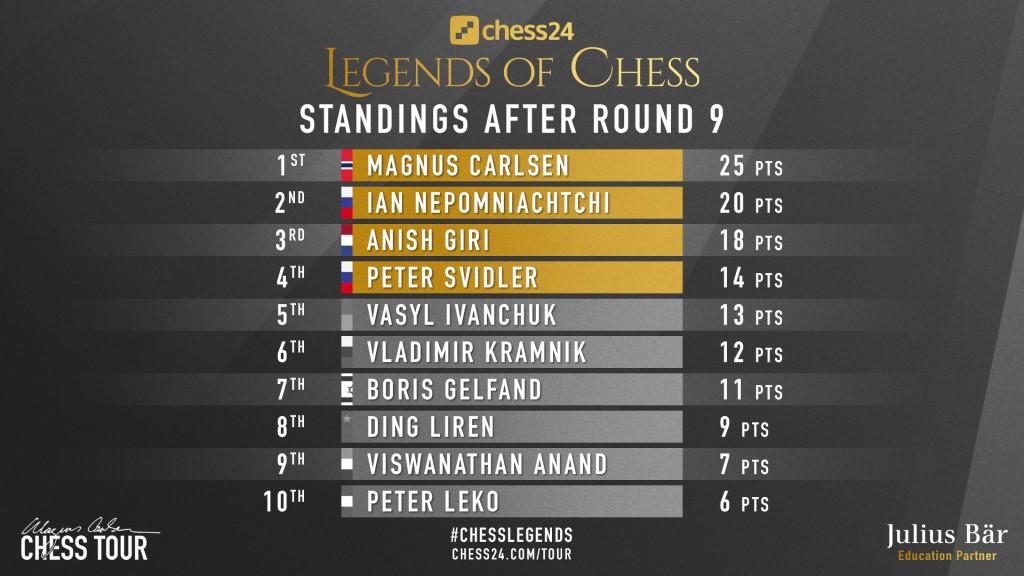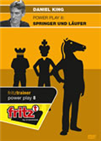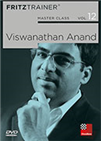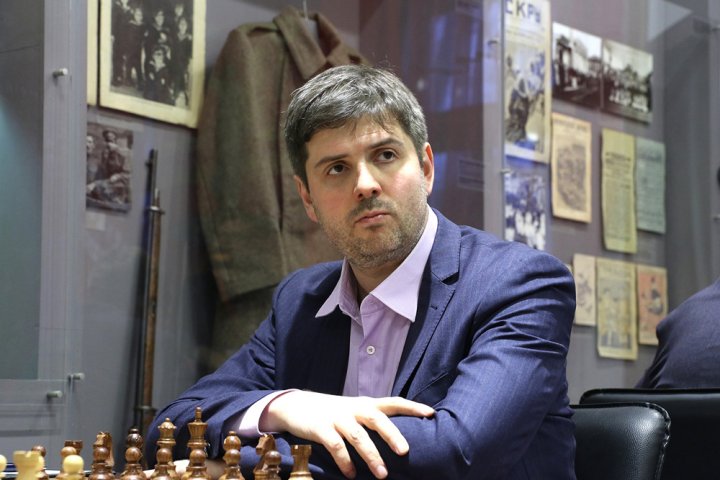On to the semis
Three players had already qualified to the knockout phase before the final round of the preliminaries: Magnus Carlsen, Ian Nepomniachtchi and Anish Giri. Peter Svidler was fourth, but he could still be caught by Vladimir Kramnik. In order for Kramnik to advance, Svidler had to lose to Giri and he had to beat Carlsen. Svidler did lose, but Kramnik could not get the better of the world champion.
The final standings of the nine-round all-play-all preliminary stage mean Carlsen will face Svidler in the first matchup of the knockout, while Nepomniachtchi is set to play against Giri in a repeat of their Chessable Masters semifinal — Giri won in three sets.
Although the course was already set for most of the other players, we got to enjoy fighting chess in some of the games.

Click to enlarge
Gelfand 3 : 2 Nepomniachtchi
Ian Nepomniachtchi apparently does not consider his Grünfeld Defence to have been disproved, despite losing with it to Carlsen in the previous round. The Russian used his favourite defence against Boris Gelfand, himself a big supporter of this opening. In the theoretical duel between the two experts, Nepomniachtchi kept the upper hand with black. Gelfand had given up a pawn looking for an advantage. Although he did not get an edge, he was by no means lost in the endgame:
 When we are starting out in chess we are told that knights and bishops both have a value of three points, but it is quite clear that in some positions a bishop is clearly superior to a knight - and vice versa. After watching this 8th Power Play DVD you’ll have a better idea of how to play positions with knights and bishops – what to look for, what to avoid, and how to place your pawns.
When we are starting out in chess we are told that knights and bishops both have a value of three points, but it is quite clear that in some positions a bishop is clearly superior to a knight - and vice versa. After watching this 8th Power Play DVD you’ll have a better idea of how to play positions with knights and bishops – what to look for, what to avoid, and how to place your pawns.
54...Rb1+ 55.Kc5? [55.Kc3 Rb3+ 56.Kd4 Ra3 and Black wins.] [Correct was 55.Ka3! Rb3+ 56.Ka2 Bb1+ 57.Ka1 Bd3 58.Rc5 and Black cannot make progress.]
55...Rb3 56.Kd6 The white king had to move far away to stop the pawn advance. But there is also an ulterior motive...
56...Ra3 57.Ke5
57... Kg4 Black is alert. [57...c3? 58.Kf4 That was the trap. With the king’s departure, mate is threatened, and so is the pawn on c3.]
58.Be7 Rxa4 59.Rc8 Ra7 60.Bf6 Ra3 61.Kd6 Kf3 62.Rh8 Ke2 63.Rh2+ Kd1 64.Kc5 Rb3 [64...c3 would have been wrong again: 65.Kb4]
65.Rf2 c3 [The time has come to push the pawn.]
66.Rf1+ Ke2 67.Rc1 c2 0–1
Boris Gelfand equalized in the second game, after Nepomniachtchi had chosen to go for an ‘online-freestyle’ strategy. Gelfand kept the white king in the centre with an exchange sacrifice and won a queen endgame in 88 moves. Two draws and an Armageddon tiebreaker followed, and the Israeli won the sudden-death decider.
Ding 2½ : 1½ Leko
The match between Ding Liren and Peter Leko saw the Chinese winning the first game and getting match victory by drawing the remaining three encounters.
Leko was a pawn down in a knight ending in game 1:
51.b4 [Zugzwang.] 51...Nd5 [51...Ke6 52.Nxg6 Nxg6 53.f5+] 52.Nxg6 Nxb4 53.f5 Nd5 54.f6 Nxf6+ [Perhaps to remove all the pawns from the board...] 55.gxf6 Ke6 56.Nf4+ Kxf6 57.Nxh5+ Kg5 58.Nf4 Kh4 59.Kf3 [Nach 59.Kd4? b4 60.Kc4 Kg3 would have worked out.] 59...b4 60.Kg2 b3 61.Nd3 Kh5 62.Kg3 Kg5 63.h4+ Kf5 64.Kf3 Ke6 65.Nc5+ 1–0
Ivanchuk* 2½ : 2½ Anand
*Drew with black in Armageddon
All five games were drawn in the match between Viswanathan Anand and Vasyl Ivanchuk. After the four draws in the rapid games, the draw in Armageddon gave Ivanchuk 2 points for the overall standings, as he was playing with the black pieces.
So how did the two matches that were relevant to decide who would get the fourth qualifying spot in the knockout go?
Giri 2½ : 1½ Svidler
After two draws at the beginning of his matchup with Anish Giri, Svidler lost game 2 in a rather brutal way.
 This DVD allows you to learn from the example of one of the best players in the history of chess and from the explanations of the authors how to successfully organise your games strategically, and how to keep your opponent permanently under pressure.
This DVD allows you to learn from the example of one of the best players in the history of chess and from the explanations of the authors how to successfully organise your games strategically, and how to keep your opponent permanently under pressure.
18...Qe7 19.Qxa6 Bxe4 20.Rc1 [20.Bxe4 Qxe4 with a double attack on the rooks.]
20...Bf5 21.Nf4 [The toughest defence here was 21.Ng1, but who wants to make that move?]
21...Bd2 22.Rxc6 Rab8 There is no really useful defence against the mate threat on b1.
23.e3 [23.Bf3 Bxf4 24.gxf4 Bh3+ leads to mate.]
23...Bxe3 24.Nd5 [24.fxe3 Qxe3 followed by mate.]
24...Rb1+ 25.Ke2 Rb2+ 26.Kd1 Qe5 [No chance for the lone white king against the army of black pieces.] 0–1
The fourth game ended in a draw.
Carlsen 3 : 1 Kramnik
The first part of Kramnik’s plan in order for him to reach the knockout had worked out fine — Svidler lost to Giri. The second part of the plan — beating Carlsen — proved to be more difficult. In the first game, Kramnik found himself in a lost position with black.
 Scarcely any world champion has managed to captivate chess lovers to the extent Carlsen has. The enormously talented Norwegian hasn't been systematically trained within the structures of a major chess-playing nation such as Russia, the Ukraine or China.
Scarcely any world champion has managed to captivate chess lovers to the extent Carlsen has. The enormously talented Norwegian hasn't been systematically trained within the structures of a major chess-playing nation such as Russia, the Ukraine or China.
27.Nc6 [27.Nf5!? with the intention of 27...Ng6 28.Nfd6 Rxd6 29.Nxd6 Qxd6 30.Qxd5 and White wins.]
27...Qc7 [After 27...bxc6 28.bxc6 Rc7 White has the good-looking 29.Nb6]
28.N6xa5 Ng6 29.h4 Rxa5 30.Nxa5 Qxa5 31.Qd3 [The cleaner execution of the idea was 31.Qc2 Nb4 32.Qb1 Rxd1 33.Rxd1 h5 34.Rd4 winning.]
31...Nb6 32.Qb1 Rxd1 33.Rxd1 h5 34.Rd4 Qc3 35.Rd6 [35.Rd3 Qe5 36.Qd1 Nc4 37.Rd4 White retains an advantage with the upcoming queenside pawns.]
35...Nc4 [Black has consolidated.]
36.Rd3 [White must watch out too: 36.Rd7 Nce5 37.Rxb7 Qc8 38.Rb6 Nf3+ 39.Kg2 Qg4]
36...Qe5 37.Rd7 b6 38.Qd1 Qf5 39.Qd3 Qh3 40.Qd1 Qf5 [40...Kh6 41.Qc1+]
41.Qd3 Qe6 42.Qd1 Qf5 ½–½
In the second game, Carlsen was again on the winning side, with black, in an endgame.
50... g6 51.Nf4 Kg7 52.Kh3 Be7 53.Kg4 Bd6 54.Nd5 h5+ [54...Be5!? 55.Ne3 Kf6 56.Nc4 h5+ 57.Kh4 Kf5 58.Ne3+ Ke4 59.Nc4 Kf4 60.Nd2 Bf6+]
55.Kg5 Na3 56.Nc3 Bc1+ 57.Kh4 Nb2 [57...Kh6 58.Ne4 g5+ folgt 59.Nxg5 Bxg5+ and Black has the wrong bishop.]
58.Ne4 Bf6+ 59.Kh3 Kf7 [Only this move spoils the win. One way to get the full point was 59...Be5 60.Kg2 Kf7 61.Ng5+ Kf6 62.Nf3 Bc7 (62...g5? 63.Nxg5) 63.Kh3 Bd8 64.Ng1 g5 65.Nf3 g4+ 66.Kg3 Kf5 (66...gxf3? 67.Kxf3) 67.Ng1 h4+ 68.Kg2 Be7 69.Ne2 Bc5 70.Kh2 Ke4 71.Kg2 h3+ 72.Kh2 Kf3 and Black wins.]
60.Ng3 [Simply threatens Nxh5.]
60...h4 61.Ne4 Ke6 62.Kg4 Now the pawns are blocked on the light squares and cannot advance.
62...Ke5 63.Nf2 Kd4 64.Kf3 Be5 65.Nh3 Bg3 66.Ng5 Ke5 67.Kg4 Bf2 68.Nh7 Ke4 69.Nf8 g5 70.Ne6 Be3 71.Nxg5+ Bxg5 72.Kh3 Kf3 73.Kh2 Bf4+ 74.Kh1 h3 75.Kg1 h2+ 76.Kh1 Kg3 ½–½
Kramnik saved two lost positions, but could not continue to find miraculous defensive resources in games 3 and 4. Carlsen won both final encounters, giving Svidler the qualification to the knockout stage.
Links
























